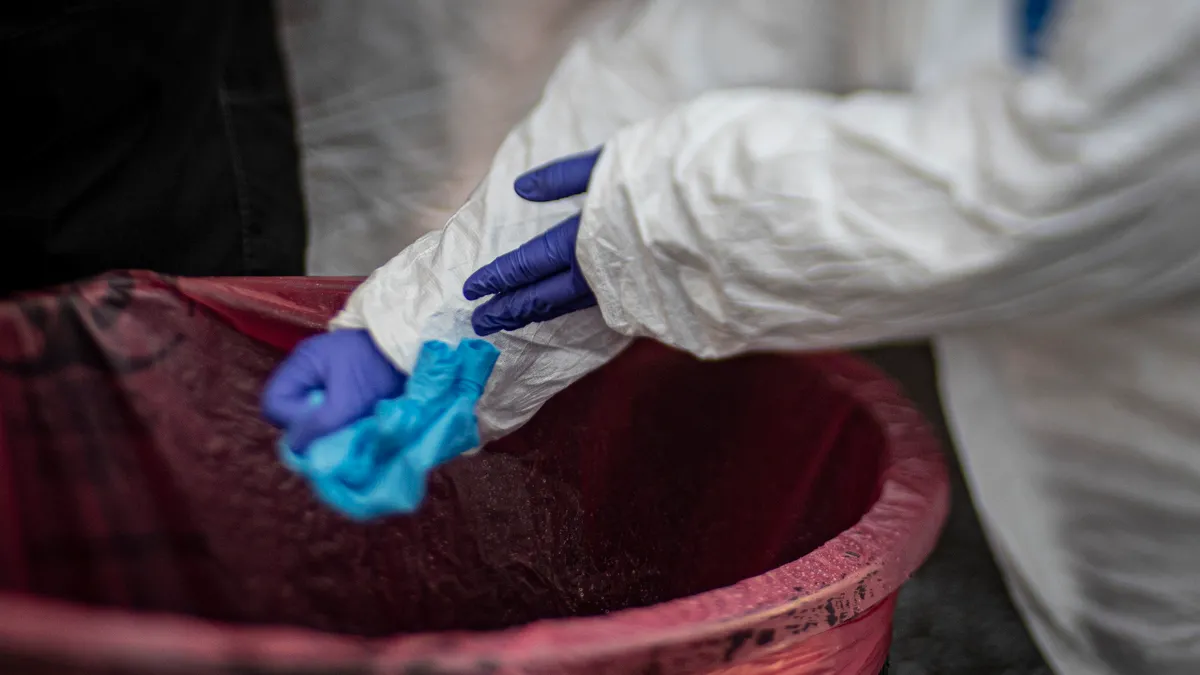Dive Brief:
- The Trump administration is defending its efforts to restock the national stockpile of personal protective equipment and other medical gear as COVID-19 cases continue to surge in the U.S.
- In a media briefing held Thursday, officials overseeing the U.S. Strategic National Stockpile pushed back on Wall Street Journal reporting that the SNS and Federal Emergency Management Agency only had 142 million N95 masks on hand, having failed to meet a goal set in May to produce 300 million masks by this time.
- Ventilators had also been in short supply in the early days of the pandemic, pressuring the Trump administration to invoke the Defense Authorization Act to spur production. HHS now says they currently have 152,600 ventilators on hand.
Dive Insight:
Coronavirus cases are skyrocketing and COVID-19 deaths hit a grim milestone this week, topping 3,000 daily deaths on Wednesday and Thursday, according to the COVID Tracking Project. Almost 107,000 COVID-19 patients are currently hospitalized, also a record, according to the group, which tracks state-level coronavirus data.
Providers are increasingly overwhelmed in some hotspots, with hospitals in states like Ohio, New Mexico and California reporting ICU capacity and supplies stretched to the limit.
In May, the Trump administration said its goal was to increase the supply of N95 respirator masks to 300 million over the next three months.
Currently, the stockpile has 164 million N95 masks, 201 million surgical and procedural masks, 84 million gowns and 65 million gloves, an HHS spokesperson told Healthcare Dive. That's compared to just 12 million N95s, 30 million surgical and procedural masks, 4 million gowns and 16 million gloves in January, before the pandemic.
"We are in a significantly better position than we’ve ever been, and in a dramatically different position than we were in January 2020," Paul Mango, HHS deputy chief of staff for policy, told reporters, noting HHS has about 15 times more N95s now than it did pre-pandemic
Shortages of PPE, testing equipment and other necessary medical supplies have defined the coronavirus pandemic, with numerous states calling for additional federal aid to procure supplies and streamline distribution. Groups of states have formed buying coalitions to leverage market power, while others have turned to commercial vendors in a bid to patch up supply gaps.
PPE shortages are endemic, according to a survey of nurses conducted by the American Nurses Association in September. Forty-two percent of respondees said they were experiencing PPE shortages, while more than half reported being forced to reuse single-use PPE, like N95s, for five or more days.
Trump administration officials didn't deny the shortages, but said the buck didn't stop with them and attempted to assuage worries about U.S. PPE supply at Thursday's media briefing.
"We’re not the Walmart that you can walk into on a daily basis to get your standard needs to treat patients and get PPE. We are a 911 response team," Mango said, asserting the stockpile hasn't denied a single state request for supplies to date.
Officials expect an influx of an additional 76 million N95s, 88 million surgical and procedural masks, 55 million gowns and 600 million gloves by year's end.
The government is also contracting with numerous manufacturers, including 3M and Honeywell, to supply another 790 million masks through October next year, HHS said.
Overall, the federal government has invested more than $530 million this year on domestic PPE manufacturing. That sum is projected to grow by several hundred million dollars as the administration finalizes other investments in nitrile glove manufacturing.
Gloves in particular are in short supply, according to an October survey of hospitals from group purchasing organization Premier, due to just a handful of overseas manufacturers controlling the market.
Once those investments are greenlit, HHS expects domestic production of gloves to grow from about 84 million to a billion or more by the end of 2021.
Trump administration officials also denied allegations they had yet to set up a centralized database for managing distribution. The government's system in partnership with major distributors representing 95% of the medical market runs biweekly shortage reports and predicts areas of greatest need, David Sanford, director of the Supply Chain Task Force, said.
HHS officials also said hospitals are consuming fewer supplies than earlier in the year as they learn better methods to care for COVID-19 patients, dropping the volume of PPE required per admission. However, the rising volume of coronavirus patients is cause for concern.
At the current rate of growth, deaths are expected to top half a million by February, according to models run by University of Washington researchers. That dire statistic could be checked, however, if a coronavirus vaccine is approved in the U.S. Late last Friday, the FDA granted emergency authorization for a vaccine developed by Pfizer and BioNTech just one day after an advisory panel to the agency said that it strongly supported the use of the vaccine.












